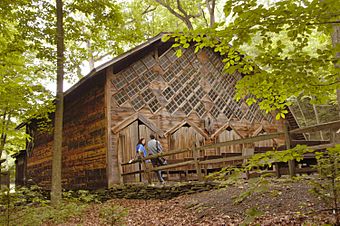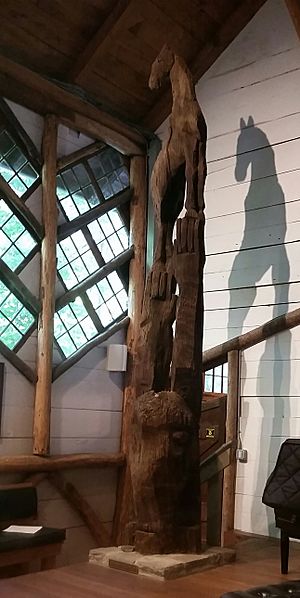Maverick Concert Hall facts for kids
Quick facts for kids |
|
|
Maverick Concert Hall
|
|

Maverick Concert Hall, Summer 2006
|
|
| Location | Off Maverick Rd., Hurley, New York |
|---|---|
| Area | 29.5 acres (11.9 ha) |
| Built | 1916 |
| Architect | White, Hervey |
| NRHP reference No. | 99001492 |
| Added to NRHP | December 9, 1999 |
The Maverick Concert Hall is a special place built in 1916. It was once part of the Maverick Artist Colony in Hurley, New York.
Today, the concert hall is home to the Maverick Concerts. This is a summer chamber music festival that runs from late June to early September. Alexander Platt is the current music director. You can enjoy beautiful chamber music concerts performed by talented musicians on Saturday evenings and Sunday afternoons.
Before the Maverick Concerts, there was the Maverick Festival. This festival started in 1915, thanks to Hervey White. It ran until 1931.
Contents
What is the Maverick Artist Colony?
The "Maverick" was a special community for artists. Hervey White, who was a writer and a friendly person, started it in 1905. He bought 102 acres of land near Woodstock.
White wanted to help young artists earn a living while they worked on their skills. He had previously helped start the Byrdcliffe Colony. However, Byrdcliffe was very organized and strict. Maverick was different; it was more relaxed and focused on artists working together freely.
What was the Maverick Festival?
The Maverick Festival began in August 1915. The first concert helped raise money to build a well for the artist colony. It was inspired by European fairs.
In July 1916, a big article about the festival appeared in The New York Times. It was titled "Music Goes Back to Nature." The concert featured classical pieces like Haydn's String Quartet Op. 77, No. 1, Max Bruch's Kol Nidrei, and Robert Schumann's piano quintet.
The festival became very popular. As more people came, it became harder to manage. The Maverick Festival stopped after 1931 due to financial problems and the large, sometimes unruly, crowds. Many people see the Maverick Festival as an early example of large music events, like the famous 1969 Woodstock festival.
About the Maverick Concert Hall Building
The historic concert hall is located in Hurley, New York. It is just outside Woodstock, in Ulster County. The building looks like a barn with a unique gambrel roof. It was built in 1916 using strong timber for its frame. The walls are made of wide wooden planks.
The hall was built by volunteers from the Maverick Colony. No architect was hired for its design. The wooden structure and its special sound qualities make it perfect for live chamber music. Because of its history and unique design, the Maverick Concert Hall was added to the National Register of Historic Places in 1999.
The Maverick Horse Sculpture
In 1924, Hervey White asked John Flannagan, a talented sculptor, to create a symbol for the colony. Flannagan was one of the first artists in the United States to use the "direct carving" method, meaning he carved directly into the material.
Using an ax, Flannagan carved a huge sculpture from a chestnut tree trunk in just a few days. The statue shows a horse coming out of a man's hands, and the man seems to be rising from the earth. This impressive 18-foot sculpture stood at the entrance to the concert hall road for 36 years.
Over time, the horse started to show wear from the weather. It was moved to a nearby studio. In 1979, it was moved again to the stage of the Maverick Concert Hall. A plaque at its base says it was repaired in 2006. The sculpture still stands there today.
John Cage and 4’33”
On August 29, 1952, a famous and unusual musical piece was performed at the Maverick Concert Hall. The pianist David Tudor played a work by the experimental American composer John Cage. Cage was a leading avant-garde composer after World War II.
His most famous piece is called 4′33″. It is often described as "four minutes and thirty-three seconds of silence." However, Cage wanted to show that not playing notes is not the same as true silence. He wanted the audience to listen to the sounds around them. These sounds could be birds singing, wind in the trees, rain on the roof, or even noises from the audience members themselves.
Recent Maverick Concerts
The Maverick Concert Hall continues to host the Maverick Concerts, a summer chamber music festival. Alexander Platt is the current music director. The main concerts feature chamber music performed by excellent soloists and groups on Sunday afternoons.
In recent years, the festival has also included more Jazz and contemporary music. There are also popular Saturday morning Maverick Family Concerts, which are enjoyed by music lovers of all ages.




